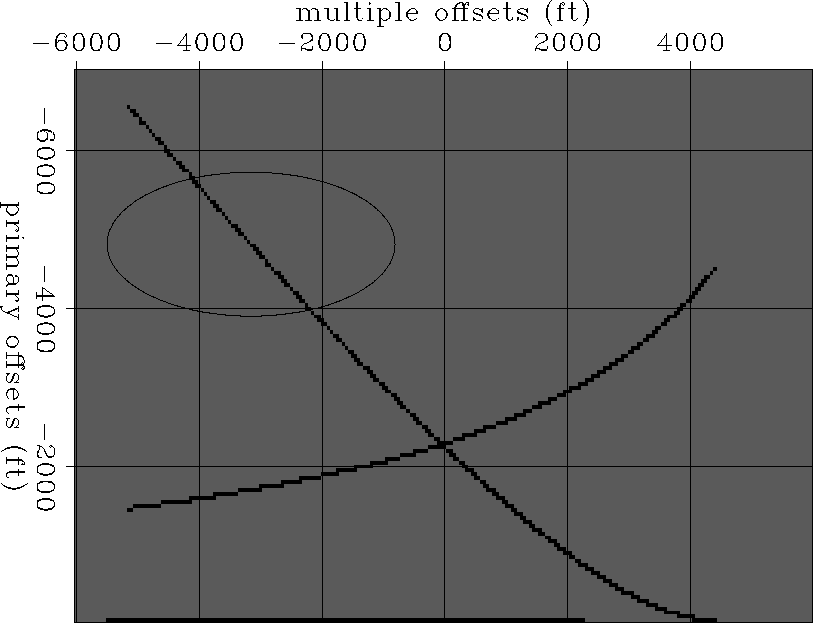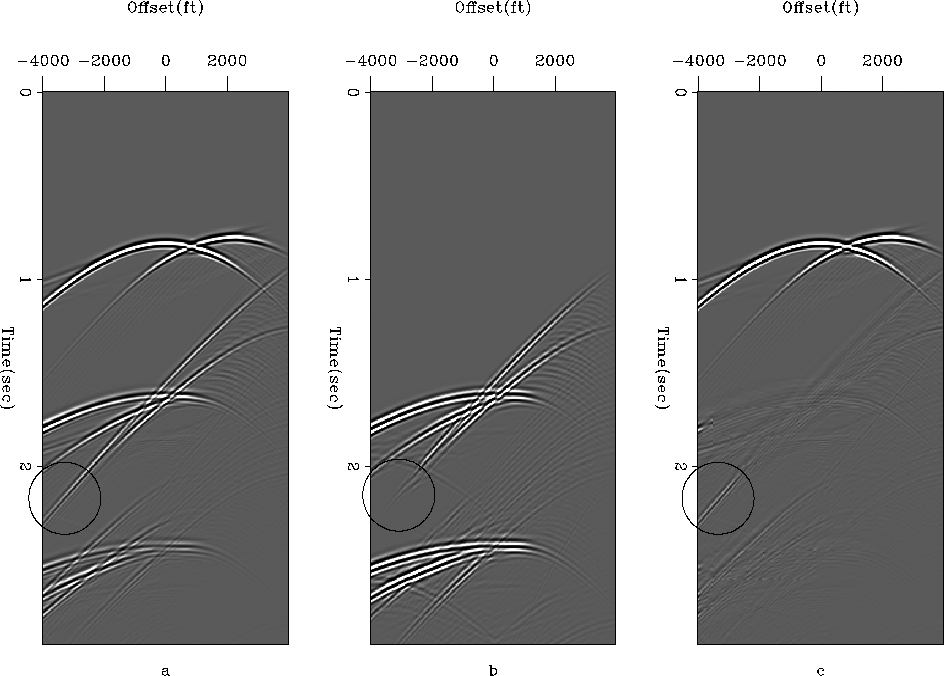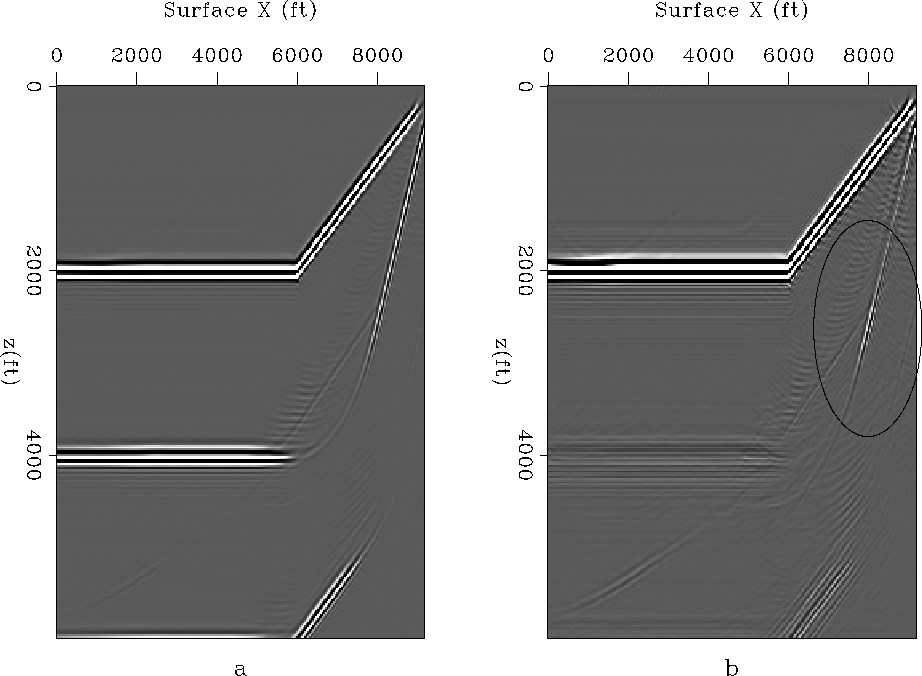




Next: Use of ADCIGs
Up: Synthetic Data
Previous: First Order Multiples -
The next step is to model these multiples using SRMP. Ideally, when we record all the offsets, SRMP could perfectly model surface-related multiples. In this section I test how the SRMP algorithm performs when we do not have access to far offsets. To simulate this situation, I throw away half the modeled offsets, keeping only the offsets from -4000 ft to 4000 ft instead of -8000 ft to 8000 ft. We would expect SRMP to fail for events that bounce back into the recording geometry (Figure ![[*]](http://sepwww.stanford.edu/latex2html/cross_ref_motif.gif) ). For the given synthetic example, first-order multiples that have either one or both bounces on the dipping surface bounce back into the recording geometry (FD,DF,DD). In the subsequent analysis we focus on the multiple which gets back into the recording geometry after bouncing twice on the dipping surface (DD), though the same may apply to other kinds of multiple events as well.
). For the given synthetic example, first-order multiples that have either one or both bounces on the dipping surface bounce back into the recording geometry (FD,DF,DD). In the subsequent analysis we focus on the multiple which gets back into the recording geometry after bouncing twice on the dipping surface (DD), though the same may apply to other kinds of multiple events as well.
To estimate first-order multiples using SRMP, we need to record two primary paths that contribute to the multiple. In Figure ![[*]](http://sepwww.stanford.edu/latex2html/cross_ref_motif.gif) , I draw a crossplot corresponding to a shot at a surface location of 5000 ft. Where on X axis is the offset at which the multiple DD is actually recorded, and on Y axis is the offset of both the primaries contributing to this multiple. Note that for the multiple recorded at an offset of about -4000 ft, the corresponding primaries are recorded at offsets of -5800 ft and -1800 ft. When we limit the maximum recording offset to -4000 ft, we will not be able to model this multiple event as one of the primary events will not be recorded. Likewise, any multiple event having either of its primaries recorded at offsets greater than 4000 ft will not be modeled. The circled portion in the figure indicates that the multiples recorded at offsets between -4000 ft and -2000 ft will not be modeled as one of the contributing primaries come at an offset greater than the maximum recording offset (4000 ft). The maximum recording offset would thus limit us to be only able to model multiples recorded at offsets of -2000 ft or less.
, I draw a crossplot corresponding to a shot at a surface location of 5000 ft. Where on X axis is the offset at which the multiple DD is actually recorded, and on Y axis is the offset of both the primaries contributing to this multiple. Note that for the multiple recorded at an offset of about -4000 ft, the corresponding primaries are recorded at offsets of -5800 ft and -1800 ft. When we limit the maximum recording offset to -4000 ft, we will not be able to model this multiple event as one of the primary events will not be recorded. Likewise, any multiple event having either of its primaries recorded at offsets greater than 4000 ft will not be modeled. The circled portion in the figure indicates that the multiples recorded at offsets between -4000 ft and -2000 ft will not be modeled as one of the contributing primaries come at an offset greater than the maximum recording offset (4000 ft). The maximum recording offset would thus limit us to be only able to model multiples recorded at offsets of -2000 ft or less.
offsets
Figure 4 Crossplot between offsets of recorded multiples and primaries contributing to those multiples
|
|  |

Figure ![[*]](http://sepwww.stanford.edu/latex2html/cross_ref_motif.gif) shows the shot gather, the multiple model created using SRMP, and the gather after adaptively subtracting the multiple model. Notice that the tail of the particular multiple event DD is not modeled between offsets of -2000 ft to -4000 ft (circled), as predicted by the crossplot in Figure
shows the shot gather, the multiple model created using SRMP, and the gather after adaptively subtracting the multiple model. Notice that the tail of the particular multiple event DD is not modeled between offsets of -2000 ft to -4000 ft (circled), as predicted by the crossplot in Figure ![[*]](http://sepwww.stanford.edu/latex2html/cross_ref_motif.gif) .
.
srme.so.5000
Figure 5 The (a) shot gather, (b) the multiple model and (c) the gather after subtracting the multiple model





Once we migrate the data after subtracting the multiple model obtained using SRMP, we expect to see some remains of the multiples in the image space, since we were unable to completely model all the multiple events. Figure ![[*]](http://sepwww.stanford.edu/latex2html/cross_ref_motif.gif) compares the two images obtained by migrations carried out on the data with and without multiple subtraction. The image obtained from the data after removing the multiple model is devoid of the flat portion of the first-order multiple, but some portion corresponding to the dipping layer remains. This dipping multiple in the image space corresponds to the event DD in data space; we were not able to model this perfectly because of limited-offset recording. Some multiple energy also remains in the bottom portion of the image, corresponding to the second-order multiple energy, but here I limit the analysis to the first-order multiple events.
compares the two images obtained by migrations carried out on the data with and without multiple subtraction. The image obtained from the data after removing the multiple model is devoid of the flat portion of the first-order multiple, but some portion corresponding to the dipping layer remains. This dipping multiple in the image space corresponds to the event DD in data space; we were not able to model this perfectly because of limited-offset recording. Some multiple energy also remains in the bottom portion of the image, corresponding to the second-order multiple energy, but here I limit the analysis to the first-order multiple events.
compim
Figure 6 Image obtained by migrating the data (a) before multiple removal and (b) after multiple removal










Next: Use of ADCIGs
Up: Synthetic Data
Previous: First Order Multiples -
Stanford Exploration Project
5/6/2007
![[*]](http://sepwww.stanford.edu/latex2html/cross_ref_motif.gif) , I draw a crossplot corresponding to a shot at a surface location of 5000 ft. Where on X axis is the offset at which the multiple DD is actually recorded, and on Y axis is the offset of both the primaries contributing to this multiple. Note that for the multiple recorded at an offset of about -4000 ft, the corresponding primaries are recorded at offsets of -5800 ft and -1800 ft. When we limit the maximum recording offset to -4000 ft, we will not be able to model this multiple event as one of the primary events will not be recorded. Likewise, any multiple event having either of its primaries recorded at offsets greater than 4000 ft will not be modeled. The circled portion in the figure indicates that the multiples recorded at offsets between -4000 ft and -2000 ft will not be modeled as one of the contributing primaries come at an offset greater than the maximum recording offset (4000 ft). The maximum recording offset would thus limit us to be only able to model multiples recorded at offsets of -2000 ft or less.
, I draw a crossplot corresponding to a shot at a surface location of 5000 ft. Where on X axis is the offset at which the multiple DD is actually recorded, and on Y axis is the offset of both the primaries contributing to this multiple. Note that for the multiple recorded at an offset of about -4000 ft, the corresponding primaries are recorded at offsets of -5800 ft and -1800 ft. When we limit the maximum recording offset to -4000 ft, we will not be able to model this multiple event as one of the primary events will not be recorded. Likewise, any multiple event having either of its primaries recorded at offsets greater than 4000 ft will not be modeled. The circled portion in the figure indicates that the multiples recorded at offsets between -4000 ft and -2000 ft will not be modeled as one of the contributing primaries come at an offset greater than the maximum recording offset (4000 ft). The maximum recording offset would thus limit us to be only able to model multiples recorded at offsets of -2000 ft or less.


